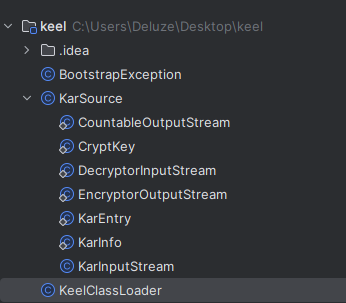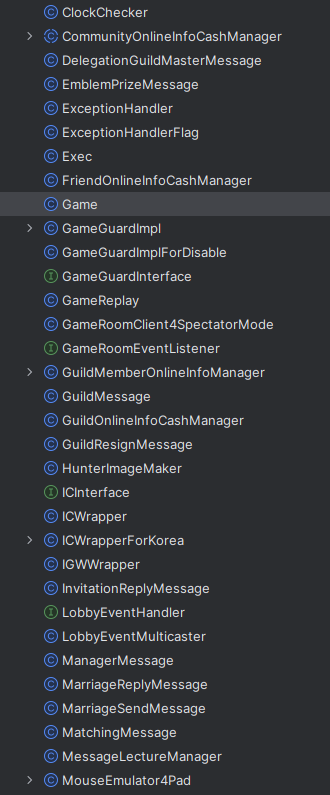Obtaining the source code of GetAmped
Any online game, at some point, will go offline. Most commonly due to a decline in player base. When these games go offline, the developers tend not to publish any server binaries or source code.
We’re talking about a 3D fighting game called GetAmped (or FogsFighters / SplashFighters). It was in development since 2002 by Cyberstep, a Japanese company. The game is popular in the Asian market, which lead up to a couple of releases in the west.
The Dutch release of this game was shut down in 2013, then got a couple of releases in different countries, but now only exists in Asia.
I was able to obtain the source code of said game, 10 years after shutdown. If you have some technical knowledge, you should be able to perform the steps mentioned in this post yourself.
Want to download the game yourself? Try the Internet Archive.
Observing the client files
These are the available client files after installing the game:
> conf/
> dists/
> jre/
> music/
> option/
> update/
> amped.kar
> amped.exe
> amped_launcher.exe
> keel.dat
> keel_aw.dll
> keel_awtcx.dll
> keel_clazz.dll
> keel_...
> resources.karWe can make some assumptions:
- The
jrefolder indicates that there’s some involvement of Java (Java Runtime Environment). - The
amped.exeandamped_launcher.exeindicate that not all binaries are Java. - The
amped.exebinary is only ~200 KB in size, which is very small for a game like this. - The
keelrelated files might hint towards the game’s engine. - After opening the
keel.dat,amped.karandresources.karfiles, it’s clear that these are encrypted.
The game has 2 executables: amped.exe and amped_launcher.exe.
The launcher was the intended way of booting up the game, it opens up an interface that originally was used to update the game. The server has been long gone, so any connection attempts fail.
Luckily for us, the game boots up just fine when running amped.exe directly.
Analyzing amped.exe
I always start with checking if there are any interesting strings present in the binary. Usually strings will give away a lot of information on what the binary does.
Windows comes with a handy strings command that extracts strings from a binary.
D:\Cyberstep> strings amped.exe
...
java/lang/ClassLoader not found.
java/lang/ClassLoader
Couldn't create Java VM.
-Djava.library.path=.;libs
-Xincgc
-Xmx%dm
OKeelRuntimeWindow_GetAmped
JNI_CreateJavaVM
Error: jvm.dll not found.
Please reinstall this software.
Keel Launcher Exe
JRE\1.3.1\bin\hotspot\jvm.dll
...After a quick search, the string "JNI_CreateJavaVM" indicates that it’s using the Java Native Interface (JNI) to
create
the JVM.
The JNI is a library you can use in C to manage a JVM and interact with it.
At this point, I’ve opened up my disassembler to see what’s going on.
We can locate one of the xrefs to the "JNI_CreateJavaVM" string and see where it’s called.
004223bf 68f8f64200 push data_42f6f8 {"JNI_CreateJavaVM"}
004223c4 56 push esi {var_2d0_1}
004223c5 ff1508f04200 call dword [GetProcAddress]
004223cb 8d54242c lea edx, [esp+0x2c {var_29c}]
004223cf 52 push edx {var_29c} {var_2cc_6}
004223d0 53 push ebx {var_2d0_2}
004223d1 50 push eax {var_2d4_1}
004223d2 e859f6ffff call sub_421a30Although this only gets the address to "JNI_CreateJavaVM" function, after analyzing the sub_421a30 function we
actually
start seeing some JNI calls in action:
00421b09 52 push edx {var_14c} {vm_args}
00421b0a 8d44240c lea eax, [esp+0xc {var_164}]
00421b0e 894c242c mov dword [esp+0x2c {vm_args_1}], ecx {var_11c}
00421b12 50 push eax {var_164} {var_174_1}
00421b13 8d4c2424 lea ecx, [esp+0x24 {var_150}]
00421b17 51 push ecx {var_150} {var_178_1}
00421b18 c744245cc0f64200 mov dword [esp+0x5c {var_11c}], data_42f6c0
00421b20 c7442464a4f64200 mov dword [esp+0x64 {var_114}], data_42f6a4 {"-Djava.library.path=.;libs"}
00421b28 c744242c02000100 mov dword [esp+0x2c {var_14c}], 0x10002
00421b30 c744243003000000 mov dword [esp+0x30 {var_148}], 0x3
00421b38 c644243800 mov byte [esp+0x38 {var_140}], 0x0
00421b3d ffd6 call esi ; JNI_CreateJavaVMOracle has some documentation
about The Invocation API which covers
the call to JNI_CreateJavaVM.
JNI_CreateJavaVM has the following signature:
jint JNI_CreateJavaVM(JavaVM **p_vm, void** p_env, void* vm_args);So from the above assembly, we know var_150 holds a pointer to a JavaVM struct and var_164 holds a pointer to a JNIEnv struct.
After renaming these variables, we can find them easier in the disassembly.
Not much further down, the "java/lang/ClassLoader" string is referenced.
00421b75 8b442408 mov eax, dword [esp+0x8 {JNIEnv*}]
00421b79 8b10 mov edx, dword [eax]
00421b7b 6870f64200 push data_42f670 {var_170} {"java/lang/ClassLoader"}
00421b80 50 push eax {var_174_3}
00421b81 8b4218 mov eax, dword [edx+0x18]
00421b84 ffd0 call eaxAfter reading some more JNI documentation, it becomes clear that this is a call to the FindClass function.
Any Java installation comes with header files for the JNI. If we’d import these, we’d get rid of those pesky “random” offsets.
I’m using Binary Ninja, so I can very easily retype JNIEnv* to its actual type, and the assembly will make a lot more sense:
00421b75 8b442408 mov eax, dword [esp+0x8 {JNIEnv*}]
00421b79 8b10 mov edx, dword [eax]
00421b7b 6870f64200 push data_42f670 {var_170} {"java/lang/ClassLoader"}
00421b80 50 push eax {var_174_3}
00421b81 8b4218 mov eax, dword [edx+0x18 {JNINativeInterface_::FindClass}]
00421b84 ffd0 call eaxFinding the compiled Java classes
The JNI is able to load compiled Java classes during runtime.
There’s a function called DefineClass that takes in a class loader
and a buffer containing raw bytes representing the compiled Java class.
Looking at the xrefs to DefineClass, we can see 10 calls to this function.
The xref takes us to a function where some data is being pushed onto the stack. 1 byte at a time…
00401290 c68424d0250000c9 mov byte [esp+0x25d0 {buf_8}], '\xc9'
00401298 c68424d125000071 mov byte [esp+0x25d1 {arg_25c1}], 'q'
004012a0 c68424d225000046 mov byte [esp+0x25d2 {arg_25c2}], 'F'
004012a8 c68424d325000007 mov byte [esp+0x25d3 {arg_25c3}], '\x07'
004012b0 c68424d4250000d1 mov byte [esp+0x25d4 {arg_25c4}], '\xd1'
004012b8 c68424d525000054 mov byte [esp+0x25d5 {arg_25c5}], 'T'
004012c0 c68424d62500008b mov byte [esp+0x25d6 {arg_25c6}], '\x8b'
004012c8 c68424d7250000fe mov byte [esp+0x25d7 {arg_25c7}], '\xfe'
004012d0 c68424d8250000ae mov byte [esp+0x25d8 {arg_25c8}], '\xae'
004012d8 c68424d925000001 mov byte [esp+0x25d9 {arg_25c9}], '\x01'
004012e0 c68424da250000b1 mov byte [esp+0x25da {arg_25ca}], '\xb1'
004012e8 c68424db2500007b mov byte [esp+0x25db {arg_25cb}], '{'It does this approximately 17,000 times. These bytes often don’t even represent characters, so it’s likely encrypted.
Reverse engineering the decryption algorithm is one option,
but why bother when we can simply put an old-fashioned breakpoint on the DefineClass call?
The DefineClass function should still be called with valid bytes that represent a Java class after all,
so the data must be decrypted before that.
Take this call for example:
00421710 8b4014 mov eax, dword [eax+0x14 {JNINativeInterface_::DefineClass}]
00421713 68a8050000 push 0x5a8 {len}
00421718 8d8c24c4100000 lea ecx, [esp+0x10c4 {buf_5}]
0042171f 51 push ecx {buf_5} {var_2c_1}
00421720 53 push ebx {var_30_1}
00421721 8d942498410000 lea edx, [esp+0x4198 {name_5}]
00421728 52 push edx {name_5} {var_34_1}
00421729 55 push ebp {var_38_1}
0042172a ffd0 call eax ; <-- BREAKPOINTand the DefineClass signature:
jclass DefineClass(JNIEnv *env, const char *name, jobject loader,
const jbyte *buf, jsize bufLen);Binary Ninja already renamed some variables for us according to the header files of the JNI,
so we know that the class name is stored in name_5, and the class data in buf_5.
There aren’t any anti-debugging techniques in place, so we can run the binary and wait until the breakpoint is hit.
After that, we can dump the decrypted class data from buf_5.
I’ve gone ahead and did this to all classes, and it gave me the following files:
> BootstrapException.class
> KarSource$CountableOutputStream.class
> KarSource$CryptKey.class
> KarSource$DecryptorInputStream.class
> KarSource$EncryptorOutputStream.class
> KarSource$KarEntry.class
> KarSource$KarInfo.class
> KarSource$KarInputStream.class
> KarSource.class
> KeelClassLoader.classIn Java, inner classes will result in a separate .class file. The hierarchy is denoted with a $, e.g.:
class KarSource {
class KarEntry {
}
class KarInfo {
}
// ...
}Decompiling the classes
Java .class files contain bytecode, which can be easily decompiled using the FernFlower decompiler. The community edition of IntelliJ IDEA comes with this decompiler built-in. All we simply need to do is store all these .class files in a single folder and open it in IntelliJ:

It’s obvious that this is not the source code of the game, but from now on its easy game as the assembly is not needed much longer.
Decrypting the keel.dat file
The implementation of KarSource contains a constructor that takes in 2 arguments:
public KarSource(String var1, String var2)After reading the source code, I’m renaming the arguments to:
public KarSource(String path, String password)There’s not much of the assembly left to reverse, but 2 strings are being referenced:
00421c8c bed8f44200 mov esi, data_42f4d8 {"dhfuhsudfh98vhdsovnfdhiouer8u8hgjbkjciudsuifsjdiosajfn"}and
00421cbe 68ccf44200 push data_42f4cc {JNIEnv*} {"keel.dat"}isn’t that suspicious?
We can include these compiled Java classes into our own Java program and use the KarSource class ourselves,
and plug in these 2 strings:
var file = "D:\\Cyberstep\\keel.dat";
var pass = "dhfuhsudfh98vhdsovnfdhiouer8u8hgjbkjciudsuifsjdiosajfn";
var source = new KarSource(file, pass);and… it works! The keel.dat file is decrypted and the contents is all ours. The KarSource implementation exposes
a simple API to extract the contents, so I’ve just done that.
It appears that keel.dat contains encrypted byte code of the game’s engine. The file contained 707 classes in total.
But what about the amped.kar and resources.kar files? We still need to find the decryption keys for those.
Decrypting the amped.kar file
The “Keel” engine expects an "-entrypath" argument to be passed, at least that’s what their source is hinting towards:
if (appClassName == null) {
System.out.println("Usage: KeelRuntime [-options] class [args...]");
System.out.println("where options include:");
System.out.println("-debug debug graphics code");
System.out.println("-entrypath <path or jar files...>");
System.out.println(" set search path for keel application classes");
System.exit(1);
}and it so happened that the -entrypath is set to "kar:program_getamped:kar".
but… the password is nowhere to be found and from the KarSource implementation, we know that a password is required.
After looking through the Keel source code, I’ve stumbled across this snippet:
// var0 = "kar:program_getamped:kar"
public static Archive openArchive(String var0) throws IOException {
if (var0.startsWith("kar:")) {
return new Archive(createKarSource(var0, ':'));
} else {
return var0.startsWith("kar;") ? new Archive(createKarSource(var0, ';')) : openArchive(new File(var0));
}
}
// var0 = "kar:program_getamped:kar"
// var1 = ':'
private static ArchiveSource createKarSource(String var0, char var1) throws IOException {
String var2 = var0.substring(var0.indexOf(var1) + 1);
String var3 = null;
String var4;
if (var2.indexOf(var1) >= 0) {
var3 = var2.substring(0, var2.indexOf(var1));
var4 = var2.substring(var2.indexOf(var1) + 1);
} else {
var4 = var2;
}
return new KarSource(var4, var3);
}See that var3 being passed as the 2nd argument to KarSource? That’s the password, and we need it.
After analyzing the source code, it seems that the password is simply "program_getamped".
That’s it.
Remember that old KarSource implementation we used to decrypt the keel.dat file?
I tried using it on amped.kar, but it didn’t work. It seemed to be able to extract the class names, but not the contents.
It appears that a newer version of the KarSource implementation is present in the keel.dat file.
So… here we go again:
var file = "D:\\Cyberstep\\amped.kar";
var pass = "program_getamped";
var source = new KarSource(file, pass);and that’s it!
After dumping the contents of amped.kar, the game’s source code has been restored.
There are over 7000 classes to be found in this one file.

Decrypting the rest of the kar files
Sorry folks, this one is rather anti-climatic. All the other passwords were super easy to find in the source code.
SETTING_KAR_PW = "setting";
PROGRAM_KAR_PW = "program_getamped";
RESOURCE_KAR_PW = "resource_getamped";
DISTS_KAR_PW = "dists_getamped";Go crazy!
Conclusion
Having the source code allows reverse engineers to learn how the game was built. It allows us to easily create our own server emulator from scratch, which is easier with source code than reading assembly.
This game offers a lot of content, albeit by pay-walling most of the weapons and classes, there were hundreds of them.
After looking through resources.kar, I’m quite blown away by how much scripting work went into this game.
If you feel like picking up on this project, please reach out to me. I’d love to keep an eye on it!
Fun fact: The code contains server related files that definitely shouldn’t be on the client-side.